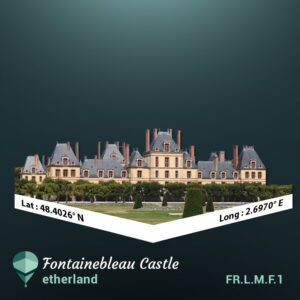 Located 55 kilometers southeast of Paris, the Fontainebleau Castle or Palace of Fontainebleau is an iconic palace of great historical importance. On top of housing many French kings and emperors throughout the late medieval years, it is also one of the largest castles of its kind. Initially built as a fortified castle in the first half of the 12th century, it was improved and turned into the current Palace up until the end of the 18th century, on the eve of the French Revolution.
Located 55 kilometers southeast of Paris, the Fontainebleau Castle or Palace of Fontainebleau is an iconic palace of great historical importance. On top of housing many French kings and emperors throughout the late medieval years, it is also one of the largest castles of its kind. Initially built as a fortified castle in the first half of the 12th century, it was improved and turned into the current Palace up until the end of the 18th century, on the eve of the French Revolution.
The Palace or Château of Fontainebleau is located just over fifty kilometres southeast of central Paris. The Kings of France had a residence here as far back as the twelfth century when a castle was first erected, but the substantive history of Fontainebleau is generally traced to the sixteenth century when King Francis I (reigned 1515–1547) began construction of a vast new Palace here. Fontainebleau was to be an expression of the Renaissance influences which had spread north from Italy to France from the late fifteenth century. It was designed by Gilles le Breton, a master mason who had impressed the king with his work on the development of the Château de Chambord in the Loire Valley in the early 1520s, a site which Leonardo da Vinci consulted on the design of during his sojourn in France before his death in 1519. Le Breton began his work at Fontainebleau in 1528 and spent much of the next twenty years overseeing the development of the Palace.
Le Breton did not level the medieval castle, but incorporated it into his work with an oval courtyard built around it, the centrepiece of which was a grand fountain wherein wine was often mixed with the water. Extensive gardens were laid out on the surrounding grounds, replete with gardens and grottos. In the interior perhaps the most famous addition was the Gallery of Francis I, a long reception chamber leading to the king’s apartments which was designed and decorated by a team of Italian painters and architects whom Francis had brought over the Alps specifically for the purpose. The Gallery was emblematic of Renaissance style. It was the first of its kind in France and would influence royal reception galleries and halls throughout Europe for centuries to come, notably the Hall of Mirrors which one of Francis’s successors, King Louis XIV, built at Versailles over a century later.
The Palace was added to by subsequent monarchs, but it was very much the legacy of Francis I and is perhaps the finest example of a palace of the Northern Renaissance. Fontainebleau was subsequently eclipsed amongst French royal palaces in the seventeenth century when Louis XIV developed Versailles closer to Paris and moved the French royal court there in 1682. Nevertheless, Fontainebleau was restored as a significant palace itself after years of neglect by Napoleon Bonaparte after he became Emperor of France in 1804. After investment in refurbishing the building it was deemed a fit prison of sorts for Pope Pius VII for a period of five years after Napoleon forced him to live in France in 1809, the better to control the Roman Catholic Church throughout Europe. It was also at Fontainebleau that Napoleon spent the final days of his first reign in 1814 before abdicating and being sent to live in exile on the Island of Elba. Today the Palace is a UNESCO World Heritage Site, having been granted that distinction in 1981. Although it continues to stand in Versailles’ shadow, upwards of half a million tourists visit the Château annually.